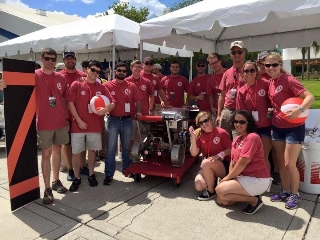Jun 4 2015
The University of Alabama is used to having teams that win national championships. Alabama Astrobotics, a robotics team made up of Shelton State and UA students, added a different kind of title to the University’s tally with its recent performance at this year’s Robotic Mining Competition hosted
by NASA.
 Alabama Astrobotics won this year’s Robotic Mining Competition hosted by NASA. Photo courtesy of Dr. Kenneth Ricks
Alabama Astrobotics won this year’s Robotic Mining Competition hosted by NASA. Photo courtesy of Dr. Kenneth Ricks
Not unlike the Crimson Tide football team, Alabama Astrobotics is the most decorated team in the history of its annual competition, with two titles. The purpose of the competition is to bring forth ideas from around the country to help NASA in their endeavors to efficiently mine materials from other planets and asteroids. Teams are judged in ten different categories, ranging from “team spirit” to “innovation.”
Kenneth Ricks, a professor of engineering and the Alabama Astrobotics sponsor, said while many of the categories, such as the required technical paper describing the robot, are subjectively graded, the actual execution of the robot in the “robotic mining” category is evaluated using a formula. This formula uses a series of penalties and rewards to measure efficiency and effectiveness. For example, for every 1 kilowatt hour of power consumed, the robot loses one point. Robots gain points for completing the task of mining material and placing it in the processing bin. Up to 500 bonus points can be earned for autonomous operation, or the robot’s ability to function without a human operator. Out of over 600 competition attempts, autonomous operation for a full 10 minutes has only been achieved three times, two of which were by Alabama Astrobotics.
“Future goals are to build upon the design that has already proven to be successful,” said Ricks. “The 2016 team will attempt to improve the autonomy system making it even more robust against potential failures. Also, the 2016 team will strive to reduce the mass of the robot by integrating carbon fiber and other lightweight materials”.
Winning this year’s competition does not mean slowing down for Alabama Astrobotics. Christina Hughes, a senior majoring in electrical engineering and the team’s logistics lead, said she has a large amount of responsibility in the group, from ordering parts and maintaining the team’s budget, to planning and executing outreach projects. Though she said is excited for the recent win, she and her teammates still have their eyes on a bigger prize.
“Participating in the NASA Centennial Challenge is the logical next step for a first-class robotics program like UA’s and will give our hungry and talented engineers something new to sink their teeth into,” Hughes said.